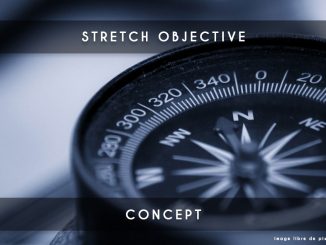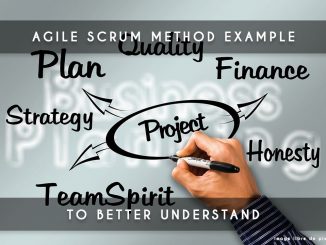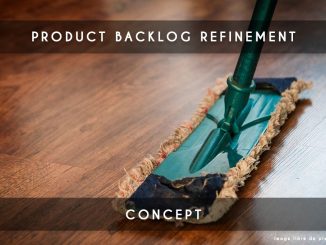
I decided to do this article in order to give you an overview of the ceremonies of a scrum sprint.
Definition of scrum sprint
The iteration or development cycle of the scrum is called a “sprint”; it usually lasts two or three weeks. Short cycles provide feedback more frequently.
But these should not be too short either, to allow time for the team to make developments to achieve realistic goals. These objectives will be called the objectives of the sprint.
And finally, the duration of the sprints must be fixed. This duration must not be changed for any reason.
Scrum model: what do we do during a sprint scrum?
A scrum sprint starts with a sprint planning and ends with a sprint review and a sprint retrospective. Every morning, the development team will align with the Daily and the team will make Product Backlog Refinement to help the Product Owner to refine the content of the backlog.

Scrum ceremonies: Sprint planning
– The goal: organize the scrum sprint that starts.
– Duration: the necessary time to finish the sprint preparation. But it’s better if it don’t exceed more than 2 hours.
– The participants: the Product Owner (PO), the Scrum Master (SM) and the entire development team (developers)
– The animators: The Product Owner is the master of ceremonies. The Scrum Master will rather be the one who will assist the Product Owner to intervene in case of need
Progression:
1. The Product Owner sets the sprint goals. Feel free to remind these goals throughout the Sprint Planning and write them directly on the board.
2. The team will have to re-estimate the story point of each of the
requests from the previous sprint that ended in “work in progress”.
This work is useless on requests that were in “todo” at the end of the previous sprint.
3. The Product Owner will offer the developers a set of requests that they will have to do during the sprint. These requests will generally meet the objectives set at the beginning of the ceremony.
4. In a modern scrum, we don’t estimate the requests during the sprint planning but we make estimates upstream of Sprint Planning. It’s during the Product Backlog Refinement that the estimatation is made. It allows the sprint planning to be faster and to make the processes as fluid as possible. On the other hand, the team can exceptionally estimate a backlog request that is essential to be done during this sprint, despite the fact that it has not been passed into Product Backlog Refinement.
5. The last step is to split all requests into technical sub-tasks. There are no precise rules for this technical division; I advise the technical teams to do the
splitting that it will feel to be as comfortable as possible.
More details on sprint planning: Sprint Planning
Each day of the scrum sprint (except the day of sprint planning), the team participates in the daily scrum.
Scrum ceremonies: Daily scrum
– Objective: the development team must be clear on the progress of the project and identify blocking points.
– Duration: 15 minutes maximum every day of the scrum sprint
– The participants: the developer team, the Product Owner (observer tolerated) and the Scrum Master (necessary if the team is not mature)
– The animators: the autonomous development team
Progression:
We take a tour of the development team and each participant must:
- Explain what he has done since the last Daily
- Say what he thinks to do until the next Daily
- Raise an alert (if any)
Attention: each member has only 2 minutes to speak. If a problem is raised and we will probably spend time talking about it, the Scrum Master will have to propose to talk about this problem after the Daily; it’s in the objective to not disturb it.
More on daily scrum: The Daily Scrum Meeting
During the sprint, once a week, the team participates at the Product Backlog Refinement formerly called Grooming.
Scrum ceremonies: Product backlog Refinement
– Objective: refine the content of the product backlog and to organize the next Sprint.
– Duration: it doesn’t last more than one hour per session, it can also last only ten minutes if the product owner doesn’t need more time
– The participants: the development team, the product owner and the scrum master
– The animators: It’s the product owner who is the master of this ceremony. The scrum master will rather be the one who will assist the product owner to intervene in case of need
Progression:
1. The product owner will offer user-stories to developers. For each request:
- Developers ask questions to the product owner to refine the request to have the capacity to estimate it if the demand is not 100% clear.
- If they have fully understood the request, they validate the request and estimate it
- Otherwise, if the developers don’t understand the request, the product owner have to review it until the next session.
2. The developers will estimate the request together in time or story point (highly recommended). You can read this article to better understand how to estimate applications with the Poker Planning method:
Planning Poker: estimate your user stories
More details on the Product Backlog Refinement:
The scrum sprint ends with the sprint review, which must take place just before the sprint retrospective.
Scrum ceremonies: Sprint review
– Objective: to review what has been achieved during a sprint. It is also interesting to present the display in order to improve the exchange between the team and the stakeholders; this in order to get a maximum of constructive feedback.
– Duration: doesn’t last more than 1 hour
– The participants: the development team, the product owner, the scrum master, the key users [optional], the stakeholders [optional] and the sponsors [optional]
– The animators: It’s the product owner (PO) who is the master of this ceremony. The scrum master (SM) will be the second animator. It is rather advisable that the PO and the SM present in pairs.
Progression:
1. The product owner presents the work done during the Sprint
2. Developers make a demo of a new feature completed or a new product completed
3. The scrum master presents some revealing indicators (burndown chart, burnup chart, donut impediment …) to explain concretely the progress of the project.
4. Questions / Answers and feedback.
More details on the sprint review:
Make a good sprint review
The sprint review is not a demo!
Scrum ceremonies: Sprint retrospective
– Objective: to work on two main axes: continuous improvement and the health of the team
– Duration: one hour
– The participants: the development team, the product owner and the scrum master
– The animators: It’s the scrum master who prepares and animates at 100%
Progression:
The scrum master will offer fun workshops to achieve the objectives of the retrospective with some golden rules:
- each retrospective must be different
- it must be animated and not monotonous
More details about the sprint retrospective: Art of retrospective
Conclusion scrum sprint – scrum model
I hope this summary article of a scrum sprint will be helpful for you. The times given are not those of the Scrum Guide but those that I personally recommend.
[this article is a translation of Mai Ly article wrote in french in the french blog]




What does “animators” mean? Do you mean the person in charge of hosting the meeting?
The person who leads the ceremony.